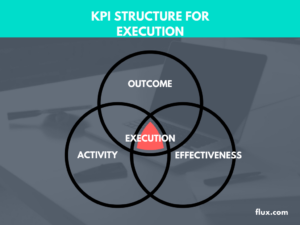The Three Categories of KPIs that Drive Growth
KPIs drive success when they follow The 3 rules that make KPIs work. These are: that they pose good questions, drive robust conversation and demand affirmative actions. I know a business has a strong KPI structure when these questions and conversations take place in open discussions about performance improvement, and when they are a part of everyday life.
In Practical Performance Measurement, Stacey Barr writes,
“What we really want is for performance measurement to be seen as a natural and essential part of work. We want people to associate it with learning more about what works and what doesn’t, with valuable feedback that keeps us on the right track and with continuous improvement of business success.”
I couldn’t agree more with Stacey on this and I firmly believe that identifying metrics in the categories I outline in this article is an essential part of driving that behaviour.
To use metrics best, it’s important to understand that they all fall into three fundamental categories. The categories are outcome, activity and effectiveness. I’m going to explore each of these types and explain the importance of representing them all in your KPI structure so that they drive execution in you business.
Outcome Metrics
There has been a lot written about how “lag metrics,” which measure something that happened in the past, such as last month’s revenue, are not KPIs, Some experts such as David Parmenter state that, “If a number has a currency sign in front of it it can’t be a KPI.” They feel that measuring something that has already happened does not help us change the future.
While, I understand the rationale behind this, I disagree. While the “lead measures” that drive results are your true KPIs, it is equally important to review the results of your efforts in context. As such the lag measures that tell us if we have been successful are an essential part of your KPI structure.
Photo by rawpixel on Unsplash
I refer to results metrics as Outcome measures. Outcome metrics are often Numeric Targets that are set as part of your strategic planning. These high level numbers are sometimes referred to as “desert island numbers,” as they are the key metrics that would tell you that everything was on track if you were away from the business on a tropical island for a period of time. You should be reviewing your Numeric Targets and organisation level Key Performance Indicators as part of your Quarterly Strategic Planning sessions with your leadership team and cascading these to your operational teams. Connecting these metrics to how individuals contribute to success is essential to executing on your strategy.
It is important to recognise that not all Outcome metrics are driven from Strategic Numeric targets. Some are about improving business as usual and these are equally important in driving a culture of taking action to improve our current business model. When the Activity and Effectiveness metrics that are assigned to individuals tell them how they are directly contributing to the successful outcomes for the business, it gives them context for why their efforts matter.
Activity Metrics
Photo by Braden Collum on Unsplash
In order to drive the results you desire it is important to understand and focus on the key things that will influence them.
Activity metrics are something that when done, influence a result later on. It is easy to assume that they are always something we want to do more of but this would be a mistake. While most activity KPIs would be “Maximise metrics”, or ones that you’d like to see increase, this is not universally the case. There are plenty of activities that we want to reduce in our business and track as “Minimise metrics.”
Deciding what activity metrics to track involves reviewing your processes to identify those few critical things that are the true indicators of future success.
For example, we might say a sales team will hit it’s revenue targets if it makes more phone calls and arranges more appointments. And while it might, what tells us if those calls were successful or the appointments are with the right people? There is usually a next step in the process and whether that is quotes sent, demonstrations given, or trials approved, there are likely to be activity metrics that tell us we are moving through the process, talking with the right people and engaging our target market.
Keep asking yourself whether something is an indication of moving towards our goal and you’ll find the key drivers of success that you can influence and improve.
One tactic that I use to identify the true activities that set us up for success is to ask “What next?” Starting with the most obvious step in a process ask, “What next?” and keep asking this, working through the implications and importance of each step in the process. You’ll often have a blinding flash of an insight that one particular step, if measured and discussed regularly, will really tell us if we are doing the right things to drive our critical results.
Effectiveness Metrics
Photo by Fleur Treurniet on Unsplash
Frequently measured as percentages, your effectiveness measures are process improvement opportunities. They are about the quality of what we do and they are an essential component of any KPI structure.
Given the choice of doing more of something or doing something better, our natural tendency is to opt for the former. It is far easier and more appealing to make more calls rather than do the hard yards of working out how to make them better.
Improving effectiveness takes vulnerability, practice and discipline. It is harder. Therefore it absolutely vital that any Activity metric has a quality measure to partner it. Holding people accountable for doing more without holding them accountable for doing it better is a recipe for mediocrity and a dangerous dark side of KPIs. As a manager, it is harder to coach people to improve what they do than to encourage them to make more effort, but being able to do so is an essential leadership skill. For example, in sales, improving conversion rate or average sales value are examples of effectiveness measures. For Operations, an example would be delivery on time, in full (DIFOT %).
Tracking Effectiveness metrics to ensure that we are improving makes us better employees and better managers. They are the most important Key Performance indicators for driving success.
Impact Of The Structure
As leaders and managers, our role is to guide decision making. If our KPI structure doesn’t provide a focus for enabling and making better decisions then we are just reporting without adding value. By making sure everybody understands the key activities that they can undertake that have the best chance of improving the outcomes we are tracking, then the structure is working.
In Transforming Performance Measurement, Dean Spitzer quotes Michael Hammer describing how this can go wrong. “The Measurement System did not connect the numbers to each other in a meaningful way or provide executives with any guidance as to how to improve them” Spitzer concludes that “As a result, managers had no idea how they could affect any of the measures. And so the measurement system reverted to being just a reporting system instead of a decision-guiding system.
This captures the essence of a good KPI structure perfectly. When you connect your activities and effectiveness to the outcomes they deliver. you set your structure up to be a decision guiding system, not a mere reporting system.
Follow and Connect with Andrew Ritchie on LinkedIn





Recent Comments